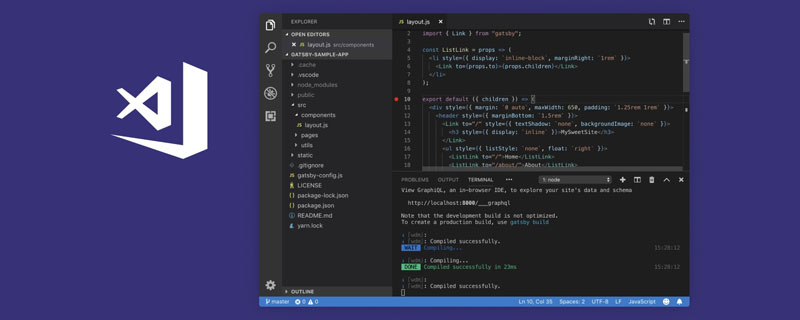
How to implement multi-level menu in Vue
In web development, multi-level menu is a very common requirement. As a popular JavaScript framework, Vue provides us with powerful tools to implement multi-level menus. In this article, I will introduce how to implement a multi-level menu in Vue and provide specific code examples.
- Create menu component
First, we need to create a menu component. This component will be responsible for rendering menu items and submenus.
<template>
<ul>
<li v-for="item in menuItems" :key="item.id" @click="handleClick(item)">
{{ item.name }}
<menu v-if="item.children" :menu-items="item.children"></menu>
</li>
</ul>
</template>
<script>
export default {
name: 'Menu',
props: {
menuItems: {
type: Array,
required: true
}
},
methods: {
handleClick(item) {
// 处理菜单项点击事件
}
}
}
</script>- Rendering multi-level menu
Next, we need to use the menu component in the parent component to render the multi-level menu.
<template>
<div>
<menu :menu-items="menuItems"></menu>
</div>
</template>
<script>
import Menu from './Menu.vue'
export default {
name: 'App',
components: {
Menu
},
data() {
return {
menuItems: [
{
id: 1,
name: '菜单项1',
children: [
{
id: 11,
name: '子菜单项1'
},
{
id: 12,
name: '子菜单项2'
}
]
}
]
}
}
}
</script>In the parent component, we pass the menu item data to the menu-items property of the menu component. The menu component will automatically render a multi-level menu based on the incoming data.
- Handling menu item click events
When the menu item is clicked, we can handle the menu item's click event in thehandleClickmethod of the menu component. Here we can trigger corresponding operations or display corresponding content.
methods: {
handleClick(item) {
// 处理菜单项点击事件
console.log('点击了菜单项', item)
}
}In this example, we simply print the menu item information in the console. You can handle the click event of menu items according to actual needs. For example, you can expand or collapse submenus on click, or jump to related pages.
Through the above steps, we have successfully implemented the function of implementing multi-level menus in Vue. You can extend and modify this code example as needed to meet your specific needs.
Summary
Vue provides us with convenient and flexible tools to implement multi-level menus. By creating a menu component and rendering and passing data in the parent component, we can easily implement multi-level menu functionality. At the same time, we can implement corresponding interactive operations by handling the click event of the menu item. I hope this article can help you implement multi-level menu needs in Vue.
The above is the detailed content of How to implement multi-level menu in Vue. For more information, please follow other related articles on the PHP Chinese website!
 聊聊vue指令中的修饰符,常用事件修饰符总结May 09, 2022 am 11:07 AM
聊聊vue指令中的修饰符,常用事件修饰符总结May 09, 2022 am 11:07 AM本篇文章带大家聊聊vue指令中的修饰符,对比一下vue中的指令修饰符和dom事件中的event对象,介绍一下常用的事件修饰符,希望对大家有所帮助!
 如何覆盖组件库样式?React和Vue项目的解决方法浅析May 16, 2022 am 11:15 AM
如何覆盖组件库样式?React和Vue项目的解决方法浅析May 16, 2022 am 11:15 AM如何覆盖组件库样式?下面本篇文章给大家介绍一下React和Vue项目中优雅地覆盖组件库样式的方法,希望对大家有所帮助!
 react与vue的虚拟dom有什么区别Apr 22, 2022 am 11:11 AM
react与vue的虚拟dom有什么区别Apr 22, 2022 am 11:11 AMreact与vue的虚拟dom没有区别;react和vue的虚拟dom都是用js对象来模拟真实DOM,用虚拟DOM的diff来最小化更新真实DOM,可以减小不必要的性能损耗,按颗粒度分为不同的类型比较同层级dom节点,进行增、删、移的操作。
 VSCode插件分享:一个实时预览Vue/React组件的插件Mar 17, 2022 pm 08:07 PM
VSCode插件分享:一个实时预览Vue/React组件的插件Mar 17, 2022 pm 08:07 PM在VSCode中开发Vue/React组件时,怎么实时预览组件?本篇文章就给大家分享一个VSCode 中实时预览Vue/React组件的插件,希望对大家有所帮助!
 手把手带你使用Vue + Laravel开发一个简单的 CRUD 应用Apr 15, 2022 pm 08:55 PM
手把手带你使用Vue + Laravel开发一个简单的 CRUD 应用Apr 15, 2022 pm 08:55 PM本篇文章给大家分享一个Vue+Laravel开发教程,介绍一下怎么使用 Vue.js 和 Laravel 共建一个简单的 CRUD 应用,希望对大家有所帮助!


Hot AI Tools

Undresser.AI Undress
AI-powered app for creating realistic nude photos

AI Clothes Remover
Online AI tool for removing clothes from photos.

Undress AI Tool
Undress images for free

Clothoff.io
AI clothes remover

AI Hentai Generator
Generate AI Hentai for free.

Hot Article

Hot Tools

mPDF
mPDF is a PHP library that can generate PDF files from UTF-8 encoded HTML. The original author, Ian Back, wrote mPDF to output PDF files "on the fly" from his website and handle different languages. It is slower than original scripts like HTML2FPDF and produces larger files when using Unicode fonts, but supports CSS styles etc. and has a lot of enhancements. Supports almost all languages, including RTL (Arabic and Hebrew) and CJK (Chinese, Japanese and Korean). Supports nested block-level elements (such as P, DIV),

MantisBT
Mantis is an easy-to-deploy web-based defect tracking tool designed to aid in product defect tracking. It requires PHP, MySQL and a web server. Check out our demo and hosting services.

SAP NetWeaver Server Adapter for Eclipse
Integrate Eclipse with SAP NetWeaver application server.

Atom editor mac version download
The most popular open source editor

MinGW - Minimalist GNU for Windows
This project is in the process of being migrated to osdn.net/projects/mingw, you can continue to follow us there. MinGW: A native Windows port of the GNU Compiler Collection (GCC), freely distributable import libraries and header files for building native Windows applications; includes extensions to the MSVC runtime to support C99 functionality. All MinGW software can run on 64-bit Windows platforms.









